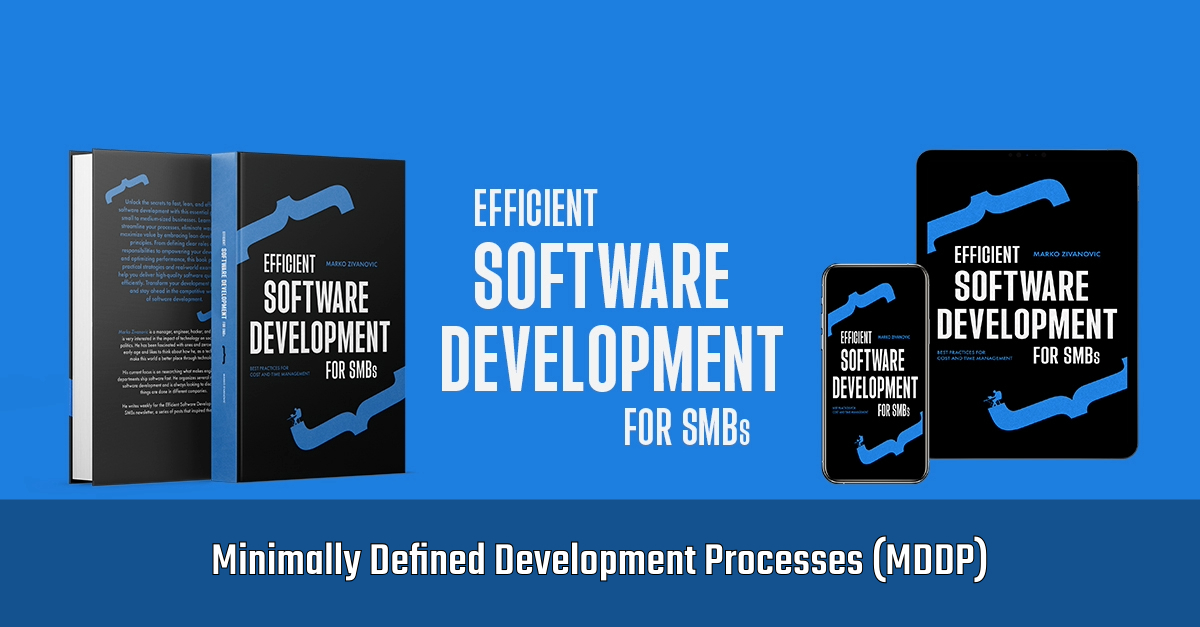Minimally Defined Development Processes (MDDP)

When determining the approach to team setup and processes, it’s crucial to avoid adopting rules that are too large for your current size. Many businesses overestimate the need for scale and adopt processes that are over-engineered and slow for their size. Most available material is written with large organizations in mind, which can be misleading for smaller companies.
This focus on large-scale solutions is logical; big companies have the resources to document and share their processes extensively. However, as a small to medium-sized business, your resources are better spent on building your product and expanding your client base.
Introduce new processes, rules, and flows only when things start breaking apart without them. Avoid adding processes in anticipation of problems; instead, implement them as a response to actual needs. Each new rule or step is a commitment of resources that will accumulate over time, multiplying as your team grows. In many cases, having no processes is better than having too many.
Companies that over-engineer their processes often have underlying issues related to role and responsibility definitions or communication problems. In contrast, teams of smart, autonomous, and proactive people usually thrive with minimal or no processes. Building and growing such a team is challenging but achievable with the right approach.
The Concept of Minimally Defined Development Processes
Minimally Defined Development Processes (MDDP) emphasize simplicity and effectiveness, ensuring that your team can work efficiently without being bogged down by unnecessary complexity. Here’s how to implement this approach:
-
Start Small and Iterate: Begin with the minimum viable process—a set of essential steps that allow you to deliver a functional product. Test this process in real-world conditions and iterate based on feedback. This approach helps avoid overengineering and ensures that your process evolves organically as your needs change.
-
Focus on Value: Prioritize tasks and features that deliver the most value to your customers. Regularly reassess what’s essential and what can be trimmed. This focus keeps your development lean and directed towards what matters most.
-
Empower Your Team: Encourage your team to identify inefficiencies and suggest improvements. Empowered teams are more engaged and better positioned to create effective, lean processes. Trust their expertise and involve them in shaping the development workflow.
-
Implement Just-In-Time Processes: Introduce processes just in time, rather than just in case. This means adding steps or rules only when a clear need arises. This approach keeps your workflow lean and responsive.
Benefits of Minimally Defined Processes
By adopting minimally defined processes, your team can benefit in several ways:
-
Increased Agility: With fewer unnecessary steps, your team can move faster and adapt more easily to changes. This agility is crucial for responding to market demands and customer feedback promptly.
-
Improved Focus: By cutting out non-essential activities, your team can concentrate on what truly matters—delivering high-quality software that meets customer needs.
-
Enhanced Morale: Teams burdened by cumbersome processes can become frustrated and disengaged. Minimally defined processes foster a more satisfying work environment, where team members feel their contributions are valued and impactful.
-
Better Resource Allocation: Simplified processes mean fewer resources are wasted on managing complexity. This allows you to allocate more time and effort towards innovation and product development.
Heuristics
- Does this process help us eliminate waste in our development cycle?
- Is quality being built into our product from the start?
- Are we fostering a culture of continuous learning and improvement?
- Is this process flexible enough to adapt to late-stage information and changing requirements?
- Are we able to deliver incremental value quickly and iteratively?
- Does this process respect and empower our team members?
- How does this process optimize the entire value stream, rather than just individual components?
Conclusion
For SMBs, adopting minimally defined development processes is a strategic advantage. It helps avoid the pitfalls of over-engineering, keeps your team agile, and ensures that your resources are focused on delivering value to your customers. By starting small, prioritizing value, empowering your team, and implementing just-in-time processes, you can create an efficient and effective development workflow tailored to your business’s unique needs.
